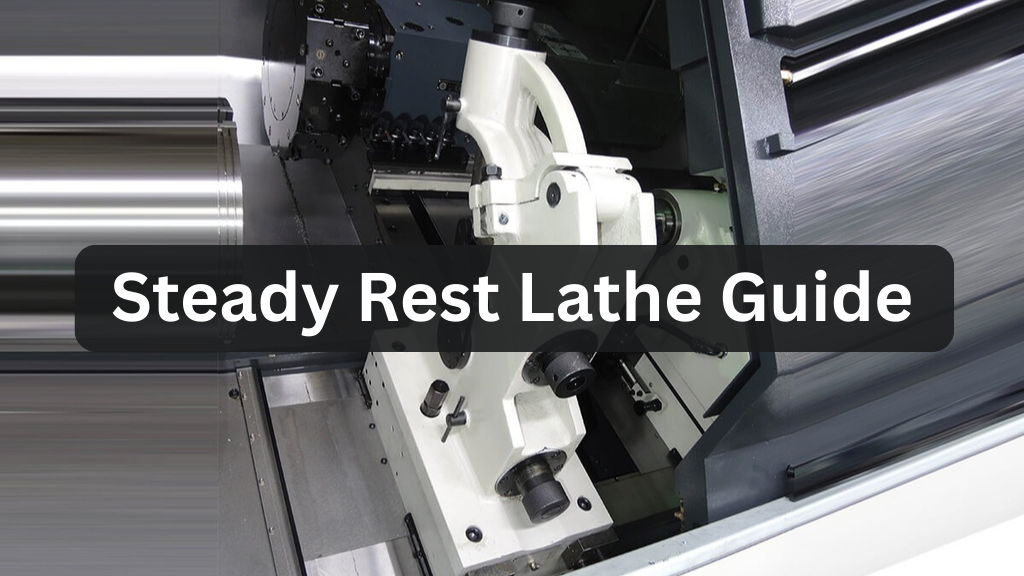A steady rest lathe is an essential tool for machinists who need precise support for long, slender workpieces during turning operations. Whether you are working on a metal lathe or a wood lathe steady rest, understanding the components, types, and best practices for usage is crucial for accuracy, safety, and quality. In this guide, we will explore everything you need to know about steady rests, from their parts and types to the differences between steady rests, follower rests, and tailstocks.
Using a steady rest improves machining precision, prevents vibration, and allows you to achieve smooth surfaces even on long or flexible workpieces. It is an indispensable tool in both professional workshops and home machinist setups.
What is a Steady Rest in a Lathe
A steady rest is a support device used in lathes to prevent long workpieces from bending or vibrating during machining. It stabilizes the material by applying pressure at specific points along the workpiece. Steady rests are particularly useful when turning shafts, rods, or other slender components that might deflect due to cutting forces.
The primary functions of a steady rest include reducing vibration during cutting, maintaining concentricity for long or flexible workpieces, improving surface finish quality, and allowing longer workpieces to be machined safely. For example, in industrial workshops, machinists often use steady rests when machining aluminum rods for automotive parts to prevent deflection and ensure uniform diameter.
Using a steady rest also enhances the safety of the machining process by preventing the workpiece from whipping or bending, which could damage tools or injure the operator.
Steady Rest Lathe Parts
Understanding the parts of a steady rest lathe is crucial for proper setup, operation, and achieving accurate machining results. Each component plays a role in stabilizing long or slender workpieces that might otherwise bend or vibrate during turning. Familiarity with these parts ensures efficient use and prolongs the life of both the lathe and tooling.
-
Base
The base of the steady rest mounts securely to the lathe bed, providing a solid foundation. It ensures that the steady rest remains stationary during operation, preventing any movement that could cause inaccuracies. A stable base is essential for maintaining alignment along the lathe axis.
-
Frame
The frame supports the fingers or jaws and provides structural integrity. Made from durable metal, it withstands the forces applied during machining. The frame allows for vertical and horizontal adjustments, ensuring the contact points can be positioned precisely on the workpiece.
-
Adjustable Fingers or Jaws
Typically, a steady rest has three fingers or jaws that contact the workpiece to stabilize it. These fingers are adjustable to accommodate different diameters and shapes, providing even support around the circumference. Proper adjustment prevents deflection and vibration during turning, which is critical for precision work.
-
Adjustment Screws
Adjustment screws control the positioning of each finger or jaw. By turning these screws, machinists can fine-tune the contact points to match the exact diameter of the workpiece. Accurate screw adjustment ensures smooth rotation and consistent alignment, reducing the risk of chatter or uneven cuts.
-
Rollers (Optional)
Some steady rests feature rollers instead of static fingers. Rollers reduce friction between the support and the workpiece, allowing smoother rotation while maintaining stability. This is especially useful for long, thin, or delicate workpieces that are prone to heat buildup or surface damage with fixed fingers.
Each of these components works together to hold the workpiece firmly while allowing smooth, controlled rotation. Understanding the parts and their functions helps machinists select the right steady rest and set it up properly for any turning operation.
Types of Steady Rest
Steady rests come in various designs to accommodate different materials, lathe types, and machining requirements. Choosing the correct type ensures stability, precision, and efficiency during turning. Each type has unique features suited to specific applications.
1. Fixed Steady Rest
A fixed steady rest provides stable support for repetitive machining tasks. It is ideal for long production runs where the workpiece diameter remains constant. Because it is not adjustable, the steady rest must match the exact diameter of the workpiece. This type offers maximum stability but limited flexibility for projects with varying sizes.
2. Adjustable Steady Rest
Adjustable steady rests allow the fingers or jaws to move, making them suitable for workpieces of different diameters. This versatility makes them popular in small workshops and for projects requiring multiple sizes. They strike a balance between support and adaptability, making them a practical choice for most turning tasks.
3. Roller Steady Rest
A roller steady rest replaces static fingers with rollers, which reduces friction and allows smoother rotation of the workpiece. This design is particularly useful for delicate, polished, or thin materials where marking or surface damage must be avoided. Rollers help maintain workpiece integrity during high-speed or precision operations.
4. Wood Lathe Steady Rest
Wood lathe steady rests are specially designed for wooden workpieces, often featuring rubber or nylon-tipped fingers. These materials prevent dents, scratches, or other surface damage while supporting the workpiece. They are commonly used in spindle turning, furniture making, and decorative woodworking projects.
Selecting the appropriate steady rest type depends on the material, workpiece length, and level of precision required. Each type offers specific advantages for different machining scenarios.
When to Use a Steady Rest Lathe
Using a steady rest at the right time ensures safer, more precise, and consistent machining results. It provides crucial support for workpieces that are prone to deflection, vibration, or surface damage during turning. Knowing the appropriate scenarios helps prevent errors and material waste.
-
Long Shafts or Rods
Steady rests are essential when turning long shafts or rods. They prevent bending and vibration, maintaining uniform diameter and concentricity along the entire length. Without support, long workpieces can whip or deflect, resulting in poor surface finish and dimensional inaccuracies.
-
Thin-Walled Tubes or Pipes
Machining thin-walled tubes or pipes requires careful stabilization. A steady rest reduces chatter and prevents the walls from collapsing under cutting forces. This support ensures the workpiece retains its intended shape while achieving smooth, precise cuts.
-
Precision Turning of Tapered Sections
When turning tapered sections, alignment is critical for accuracy. A steady rest maintains proper orientation of the workpiece, allowing precise taper angles and consistent diameter transitions. It minimizes the risk of misalignment during complex operations.
-
Delicate or Brittle Materials
For fragile or brittle materials, a steady rest provides stability and reduces the risk of breakage. By supporting the workpiece along its length, it allows controlled cutting without applying excessive stress that could crack or damage the material.
A good rule of thumb is to use a steady rest when a workpiece extends more than three to four times its diameter. This guideline helps prevent bending, vibration, and other issues that can compromise machining quality.
Difference Between Steady Rest and Follower Rest
While both steady rests and follower rests provide support to the workpiece, they function differently and are suited for distinct applications. Understanding their differences is crucial for choosing the right support during lathe operations.
-
Steady Rest
A steady rest is mounted on the lathe bed at a fixed position. It supports the workpiece at a specific point, preventing bending and minimizing vibration. This makes it ideal for long, slender components that might deflect under cutting forces.
-
Follower Rest
A follower rest moves along with the carriage, trailing the cutting tool. It provides continuous support during deep cuts or finishing passes, ensuring the workpiece remains stable along the length of the cut. This dynamic support is especially useful for high-precision machining.
Choosing between the two depends on machining needs. Use a steady rest for static, long-piece support, and a follower rest for operations requiring continuous, moving support.
Difference Between Steady Rest and Tailstock
The tailstock is another essential support device on lathes, but it serves a different function compared to a steady rest. Both are used to stabilize workpieces, yet their applications and designs vary significantly.
-
Tailstock
The tailstock supports the end of the workpiece, often using a fixed center or drill attachment. It is primarily used for drilling, reaming, or providing end support during turning operations. Tailstocks are positioned at the lathe’s tail end and can be moved along the bed to accommodate different workpiece lengths.
-
Steady Rest
A steady rest stabilizes the middle portion of the workpiece, using adjustable fingers to fit varying diameters. Its main purpose is to prevent bending, reduce vibration, and maintain alignment for long or slender components during turning.
By understanding these differences, machinists can select the right support device for their projects. Tailstock is ideal for end support and drilling, while a steady rest is best for mid-section stabilization and vibration control.
How to Install a Steady Rest on a Lathe
Proper installation of a steady rest is essential for safe and precise machining. Ensuring correct setup helps maintain workpiece alignment and prevents vibration during turning operations.
Step 1: Clean the Lathe Bed and Steady Rest
Before installation, clean the lathe bed and the base of the steady rest thoroughly. Removing debris and dust ensures stability and prevents the steady rest from shifting during use.
Step 2: Position the Steady Rest
Slide the steady rest onto the lathe bed and place it at the desired location for support. Ensure it is aligned with the section of the workpiece that requires stabilization.
Step 3: Adjust the Fingers
Set the fingers of the steady rest to lightly touch the workpiece. Avoid over-tightening, as excessive pressure can distort the workpiece or increase friction.
Step 4: Check Movement
Rotate the workpiece by hand to confirm it moves smoothly without binding. This step ensures the steady rest is properly aligned and the fingers are correctly adjusted.
Step 5: Secure the Steady Rest
Tighten the base of the steady rest and the adjustment screws to hold it firmly in place. Verify that it remains stable before beginning any machining operation.
Step 6: Begin Machining
Start the lathe and monitor the workpiece for proper alignment. Periodically check the fingers and adjustments to maintain consistent support throughout the operation.
Tips for Using a Steady Rest Lathe
- Match the steady rest size to your workpiece for optimal support.
- Use lubrication for metal parts to reduce friction and wear.
- Avoid excessive pressure from fingers or rollers, which can leave marks or distort the workpiece.
- Periodically check alignment during long machining runs to ensure consistent quality.
- For woodworking, use soft tips or rubber pads to prevent surface damage.
- Clean and maintain the steady rest after each use to prolong its lifespan.
These practices ensure that the steady rest functions efficiently and safely.
Maintenance of Steady Rests
Proper maintenance is essential to keep a steady rest functional and precise.
- Clean after each use to remove chips, dust, and debris.
- Lubricate contact points, screws, and rollers regularly to prevent wear and friction.
- Inspect fingers, jaws, and rollers for signs of bending or wear.
- Replace worn components immediately to maintain accuracy.
- Store the steady rest in a dry environment to prevent rust and corrosion.
Routine maintenance increases the lifespan of the steady rest and ensures reliable machining results.
Real-World Examples of Steady Rest Use
In professional workshops, steady rests are used extensively for precision work. Some examples include:
- Machining long steel shafts for automotive engines, where vibration could lead to misalignment and costly scrap.
- Turning aluminum rods for aerospace components, requiring precise tolerances.
- Creating wooden spindles for furniture, using a wood lathe steady rest with soft rubber tips to prevent denting.
- Producing thin-walled pipes for plumbing applications, stabilized to prevent collapse during turning.
These examples highlight the versatility and importance of steady rests across industries.
Conclusion
A steady rest lathe is a vital accessory for precision machining, especially when working with long or flexible workpieces. By understanding its parts, types, installation methods, and differences from other support devices, machinists can improve accuracy, surface finish, and safety. Whether you are operating a metal lathe or a wood lathe, incorporating a steady rest into your workflow ensures professional-quality results. Proper use, maintenance, and adjustment are key to achieving the best performance from your steady rest lathe.
Investing time in learning how to use a steady rest effectively pays off in higher-quality work, safer operation, and more efficient machining processes. For workshops and hobbyists alike, a steady rest is an indispensable tool in the lathe setup.
FAQs
What is steady rest in a lathe?
A steady rest is a support tool mounted on the lathe bed to stabilize long or flexible workpieces during turning, reducing vibration and deflection.
What is the difference between steady rest and follower rest?
A steady rest supports the workpiece at a fixed point, while a follower rest moves with the cutting tool to provide continuous support.
When should I use a steady rest lathe?
Use it when machining long, slender, or flexible workpieces that might bend or vibrate during cutting.
Can steady rests be used on wood lathes?
Yes, wood lathe steady rests are available with soft tips to prevent denting or marking wooden pieces.
What is the difference between steady rest and tailstock?
The tailstock supports the end of the workpiece, while the steady rest stabilizes mid-length sections to prevent bending.




